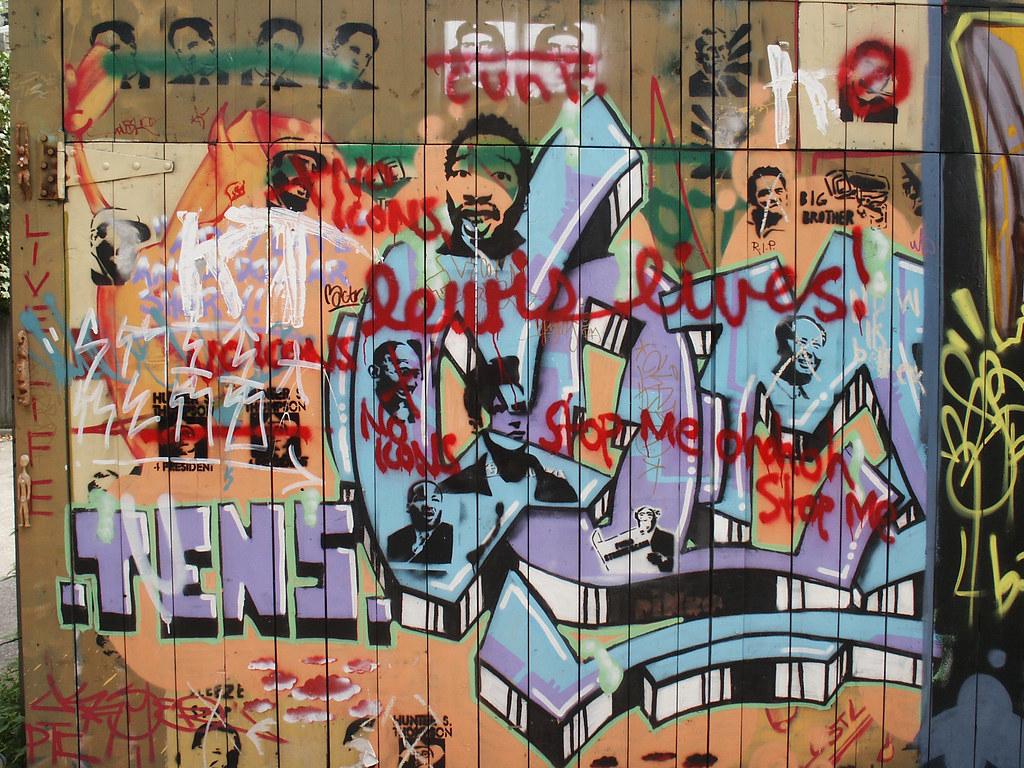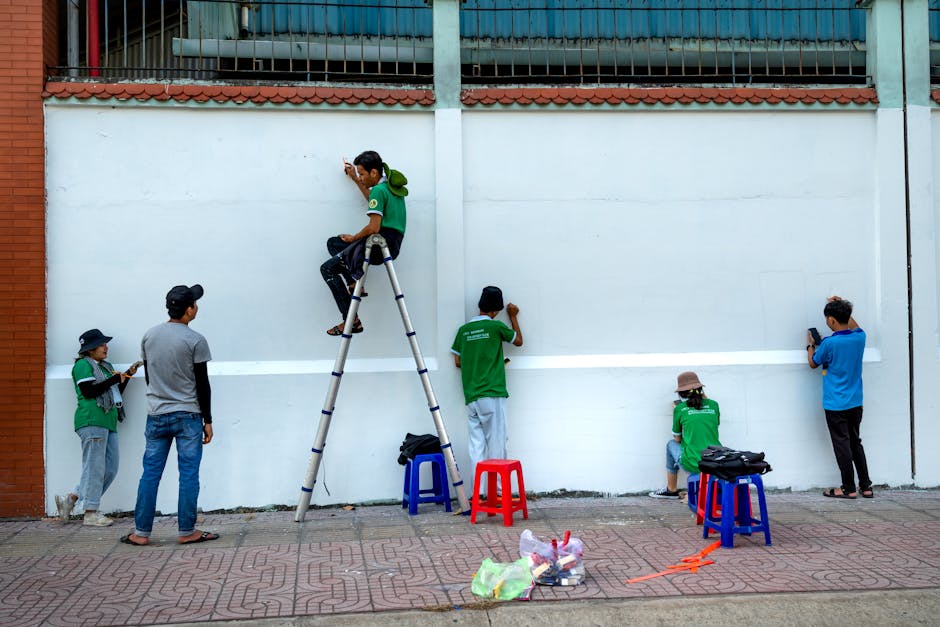Street art stands as a vibrant testament to the power of public expression, intertwining with political and social themes across the globe. From ancient scribbles on Roman walls to modern murals in bustling cities, this art form reflects the voices of communities and challenges societal norms.
Historical Roots of Political Street Art
Street art's political origins date back to ancient times. Roman citizens scribbled notes on brick walls around the 1st century B.C.E., voicing what couldn't be said aloud. This set the stage for political graffiti centuries before the French Revolution.
During the French Revolution, art became a tool for rebellion against societal hierarchies. Paint gave voice to the voiceless, a trend that continued with the Berlin Wall. One side of the wall told stories of unity and hope, while the other stood stark – a testament to those pushing against oppression.
From this era, street art gained its "vandalism" tag but also became a tool for political rebuttal and social commentary. In the 1970s, American graffiti writers united against societal and economic injustices. Some artists were chosen to display in high-brow spaces, highlighting power dynamics and bringing dissent to elite culture.
In California, amid growing gentrification, street art became a form of resistance against oppressive systems and societal erasure. It offered a canvas for unscripted tales, laid bare in open spaces rather than behind closed gallery doors.
Beyond famous names like Banksy, the craft's essence remains in its audacity to tell stories of everyone, especially those marginalized by traditional art circles. Each spray and line tells tales of defiance, serving as vibrant history books on concrete canvases.
Street Art as a Tool for Social Change
Street art plays a crucial role in stirring social and political change. It's a bold declaration echoing through urban landscapes, demanding attention to often overlooked issues. From addressing systemic racism to spotlighting environmental degradation, street art both reflects and instigates societal dialogue.
In Oakland, California, artists like DeVante Brooks create large-scale murals that recount stories of racial injustice and inspire action. In Bogotá, Colombia, muralists defy past violence with depictions of hope and resilience, while also criticizing systemic failures.
Environmental issues are also addressed through street art. Portugal's Bordalo II creates trash sculptures that provoke awareness of pollution and encourage shifts towards safer ecological practices.
In Kingston, Jamaica, street art aids in community reconciliation and revitalization. Murals merge music-infused culture with visual storytelling, fostering inclusive spaces and economic development.
Street art's beauty lies in its immediacy and accessibility. Unlike traditional galleries, the open-air canvas invites everyone to engage with its message. Whether highlighting racial justice or environmental stewardship, these artworks compel us to reflect, question, and act – engraving themselves into the legacy of change.
Profiles of Influential Political Street Artists
Banksy, a renowned yet elusive figure, critiques modern society's vices through works laced with humor and wit. His Walled Off Hotel near the West Bank barrier in Bethlehem draws attention to Israeli-Palestinian tensions, inspiring dialogue and dissent.
French artist JR employs public art installations to weave tales of social justice and community identity. His "Inside Out" campaign and "Women Are Heroes" series spotlight the strength of women in conflict zones, creating a global mosaic bonded by shared humanity.
In the United States, Shepard Fairey redefines political street art through graphic design and subversion. His "Obey" campaign encourages questioning authority, while his "Hope" poster for Barack Obama's 2008 campaign became a symbol of optimism transcending borders.
These artists, though distinct in their expressions, converge on a platform of social critique and activism. Their work ripples across local and global scales, etching messages of resistance, hope, and reflection on urban canvases. By blending art with advocacy, they underscore street art's significance as a tool for cultural and political discourse.

The Intersection of Street Art and Community
Street art forges powerful communal identities, serving as a catalyst for connection among diverse groups and a voice for the marginalized. In Philadelphia, political murals and graffiti transform public spaces into arenas of solidarity and expression. Artists like YOMI use urban canvases to challenge oppressive themes, fostering a sense of belonging and encouraging dialogue.
In Valparaíso, Chile, street art thrives as a storybook of cultural resistance. Following the fall of the Pinochet dictatorship, the city embraced street art as a legal display of public identity. Murals echo community histories, tales of struggle, and dreams of liberation.
Kingston, Jamaica's art district showcases murals celebrating music, unity, and resilience, revitalizing forgotten spaces and offering new stories of identity. This transformation encourages community reconciliation, building bridges across age-old rifts through creativity and collaboration.
Street art serves as a democratic platform that invites all passersby to partake in its tale. It advocates for stories often overshadowed by dominant cultural themes, offering marginalized voices a megaphone through spray paint and bold strokes. Through this medium, communities are seen, heard, and connected – striking chords of unity amidst the urban symphony.

Challenges and Controversies in Political Street Art
Political street art faces challenges that test its resilience and impact. Legal constraints often label it as vandalism rather than public discourse. Censorship presents another barrier, as artists encounter resistance from those who deem their work too provocative or politically charged.
Commercialization poses a threat to street art's raw authenticity. The integration of street art into mainstream platforms and its appropriation by commercial interests risks diluting its essence. As street art transitions from walls to wallets, the tension between artistic purity and financial allure becomes a subject of debate.
Gentrification of street art is a contentious issue. As urban neighborhoods transform, murals and graffiti are often appropriated or sanitized, sometimes at the expense of the communities that originally embraced this art form. Walls that once shouted out in defiance may become mere backdrops for trendy establishments.
The tension between public art and vandalism persists, raising questions about ownership and intent. Street art champions accessibility and inclusivity, but is sometimes perceived as trespassing on public or private property. This raises questions about who has the right to impose their vision upon communal spaces.
Despite these hurdles, political street art endures as a force of creativity and resistance. Its challenges are emblematic of its power to provoke thought and spark dialogue. Even as its future feels uncertain, this art form continues to stand as both a mirror and a magnifying glass, reflecting society's intricacies while amplifying voices that demand to be heard.
Street art remains a powerful medium for voicing dissent and fostering community identity. Its ability to provoke thought and inspire change underscores its enduring significance in our urban landscapes.
- Philips SA. Political graffiti is a critical intervention in urban space. Los Angeles Times. 2020.
- Haider A. How street art has memorialised George Floyd. BBC Culture. 2020.
- UNESCO. Valparaíso: Creative City of Music. UNESCO Creative Cities Network. 2015.






















